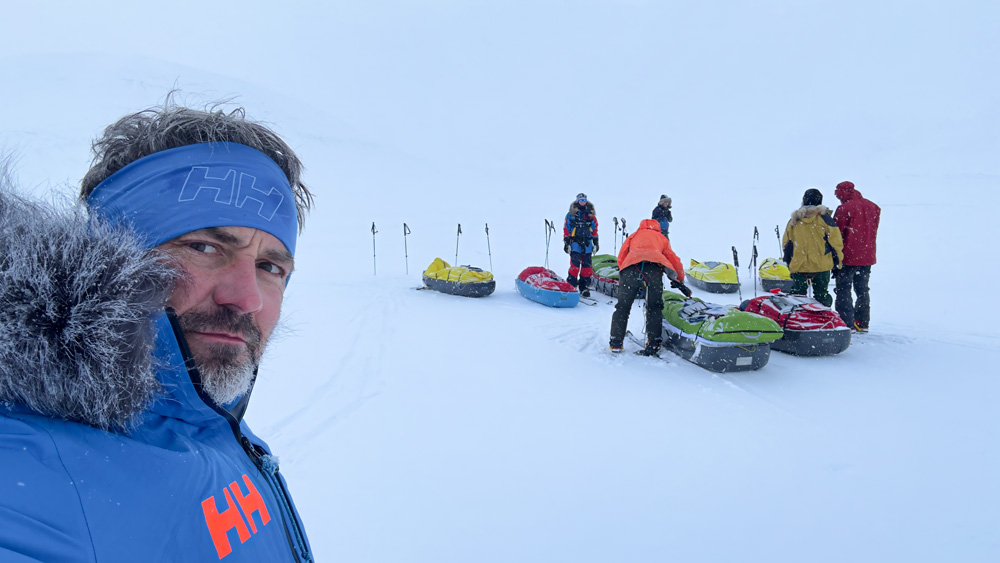Starting tomorrow May 5, 2025, I’m launching my year-long training for a 540km Greenland Ice Cap crossing in May 2026, dragging a 70-80kg sled for 25 days. This expedition – requiring sled dragging, pole use, cross-country skiing, and sometimes crampon trekking – demands a periodized approach: strength-focused for the next two months at home, emphasizing rucking, tire dragging, and long hikes three times a week, shifting to cardio and muscle endurance by December 2026.
Periodization, cycling strength, cardio, and endurance phases, is key not just for Arctic expeditions but for any fitness journey, ensuring progressive overload and recovery. Below are my top 10 exercises (most definitely not an exhaustive list) for expedition prep, chosen for their mechanical strength and endurance benefits, targeting prime movers critical for the ice.
These are accessible to adventurers and fitness enthusiasts, with an invite (challenge) to join a 4-5 day Svalbard expedition in March 2026 where I will be testing gear and prepping for my Greenland trip but that will give you a next level incredible experience and a great way to cultivate resilience and a strong mindset.
Why These Exercises?
Arctic expeditions require maximal strength for pulling heavy sleds, muscular endurance for long days, and aerobic capacity for sustained effort. These exercises mimic expedition movements—quads and glutes for propulsion, deltoids and lats for pole work, and calves for crampon steps—while enhancing functional fitness for any goal, from hiking to mental toughness. The physiological sigh (double inhale, slow exhale) complements training by resetting stress, engaging the parasympathetic nervous system.
Top 10 Exercises
Below are the 10 most valuable exercises for Arctic expedition training, with their prime movers and why they matter. No sets/reps are prescribed, letting you tailor intensity to your level.
- Back Squats (Prime Mover: Quadriceps)
Value: Powers leg drive for sled pulling and skiing, building quad strength for propulsion.
Science: Increases ground reaction forces, key for locomotion (Escamilla et al., 2000). - Deadlifts (Prime Mover: Gluteus Maximus)
Value: Engages glutes and hamstrings for sled drag power, strengthening the posterior chain.
Science: Boosts posterior chain activation, reducing lower back stress (Cholewicki et al., 1991). - Banded Lateral Walks (Prime Mover: Gluteus Medius)
Value: Strengthens abductors to stabilize hips during sled dragging, reducing fatigue.
Science: Enhances pelvic stability, key for long-distance trekking (Neumann, 2010). - Seated Overhead Press (Prime Mover: Deltoids)
Value: Strengthens anterior deltoids for arm swinging and pole pushing, critical for repetitive linear motion.
Science: Boosts shoulder girdle stability, reducing injury risk (Escamilla et al., 2009). - Straight-Arm Pulldowns (Prime Mover: Latissimus Dorsi)
Value: Mimics arm swing and pole pulling, building lat endurance for long hours.
Science: Improves eccentric control, reducing fatigue in pulling motions (Roig et al., 2009). - Skull Crushers (Prime Mover: Triceps Brachii)
Value: Powers triceps for pole extension, supporting linear arm motion in the sagittal plane.
Science: Improves elbow extensor strength, enhancing endurance for repetitive tasks (Lehman et al., 2004). - Seated Calf Raises (Prime Mover: Soleus)
Value: Builds soleus endurance for prolonged crampon walking, supporting linear trekking.
Science: Enhances slow-twitch fiber endurance, vital for sustained efforts (Edgerton et al., 1975). - Kettlebell Swings (Prime Mover: Gluteus Maximus)
Value: Powers glutes and hips for sled pulling, boosting explosive strength.
Science: Improves hip extensor power, key for locomotion (Lake & Lauder, 2012). - Bicycles (Prime Mover: Obliques)
Value: Strengthens core for torso stability during pole use, aiding balance on uneven ice.
Science: Boosts core stiffness, critical for force transfer (McGill, 2010). - Farmer’s Carries (Prime Mover: Trapezius)
Value: Builds grip and trap strength for holding poles and carrying loads, boosting mental toughness.
Science: Enhances isometric strength in the upper back (Winwood et al., 2014).
Practical Tips
- Beginners: Start with bodyweight versions (e.g., air squats, push-ups instead of overhead press) and light resistance (e.g., 5kg ruck). Focus on form, progress slowly.
- Fitness Enthusiasts: Use these for leg power, posture, or low-impact endurance. Pair with apps like RP Strength Diet Coach for nutrition.
- Recovery: Rest 1-2 days/week, stretch (glutes, shoulders), and foam roll. Use the physiological sigh to manage stress.
- Mindset: Embrace discomfort (e.g., long walks) to build resilience, key for expeditions or life.
Mental Preparation: The Missing Piece
I’ve designed and locked in my program for the next two months, with plans to reassess every eight weeks. What I haven’t addressed yet is mental preparation which is arguably where expeditions are won or lost. From my experience as a Mindset & Performance coach, psychological resilience often determines success more than physical capability, both in training and on the ice. And yeah, in real life as well.
The mental challenges of polar expeditions are unique: isolation, monotony, extreme conditions, and the psychological weight of knowing you’re days from help. Even dedicated athletes can struggle when facing the endless white horizon where progress seems imperceptible despite hours of effort.
What separates those who complete expeditions from those who don’t isn’t always physical conditioning but mental frameworks – strategies for managing discomfort, techniques for staying present during difficult moments, and tools for maintaining focus when fatigue sets in.
In upcoming posts, I’ll explore the psychology of Arctic training: visualization practices, cognitive strategies for pushing through plateaus, and methods for building psychological endurance alongside physical stamina. I’ll share specific mindset routines I’m incorporating alongside physical training and how they complement each other.
This mental dimension is precisely why I believe everyone should attempt something that pushes their perceived limits. The insights gained from testing yourself in challenging conditions transfer directly to everyday resilience. There’s profound value in discovering the gap between what you think you can do and what you’re actually capable of accomplishing.
The wisdom you’re looking for can be found at the extreme edges of the human experience.
Stay tuned for more on the psychology of expedition preparation. It’s an aspect of training that doesn’t get enough attention but often makes the difference between turning back and pushing through.
Wanna Give Arctic Expeditions a Try?
Want to experience the Arctic with me? I’m doing a 4-5 day on-ice expedition in Svalbard in late March 2026 to test equipment, hone skills, and dive into mindset and resilience. It’s a rare chance to navigate ice, drag sleds, and grow through challenge—one of the best experiences you’ll ever have. I’m being serious. Get in touch!
Final Word
These exercises aren’t just for Greenland – they’re for anyone chasing strength and grit. Quads and glutes power your steps; deltoids and lats drive your poles; resilience carries you through.
Start tomorrow, like me, and build a body and mind ready for anything.
I’ll be documenting this journey as I go – sharing real training logs, obstacles faced, and lessons learned along the way. This isn’t just about crossing Greenland but about the everyday process of becoming stronger and more resilient. Expect regular updates on workout progressions, gear testing, and the mental challenges that come with preparing for extreme conditions – both here on the blog and on my expedition channel on my IG.
Whether you’re planning your own adventure or just curious about what goes into this kind of preparation, I hope these insights prove valuable. My path to the ice is long, and having you along for the ride makes the training more meaningful. Questions, advice, or just want to follow along? I’ll bring you into the mud, sweat, and occasional tears of this preparation, because the real magic isn’t in the destination, but in the person who emerges from the grind.
Follow along not for inspiration, but for honest companionship in your own battles, whatever they may be. The ice is waiting.
Let’s get to work.
Stay safe.
And don’t forget to be awesome







